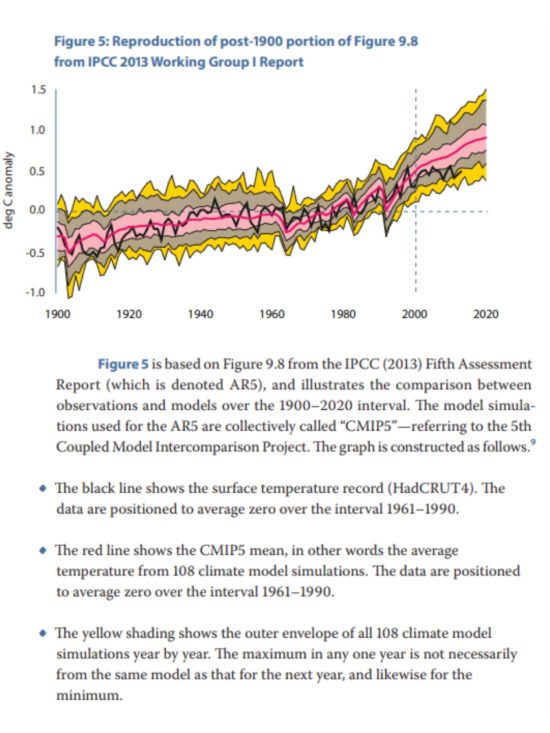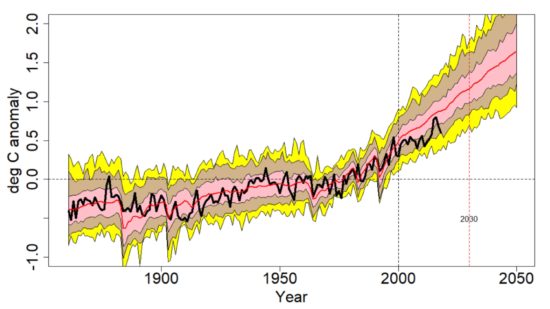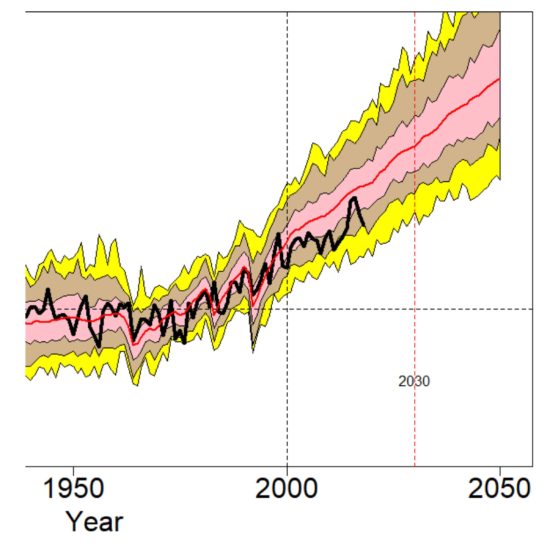The following is a re-posting of an article by Dr. Ross McKitrick, University of Guelph, published yesterday, November 11, 2019. I have a comment that follows his post.
Climate Models vs Observations: 2019 Update
Back around 2014 many people, me included, were commenting on the discrepancy between climate models and observations. In a report for the Fraser Institute I showed the following graph:

The HadCRUT4 series (black) was then dipping below the 95% lower bound of the model distribution. The IPCC itself in the 5th Assessment Report (2013) noted that out of 114 model runs, 111 had overstated observed warming since the late 1990s. That same year, Hans von Storch told Der Spiegel that:
“If things continue as they have been, in five years, at the latest, we will need to acknowledge that something is fundamentally wrong with our climate models. A 20-year pause in global warming does not occur in a single modeled scenario. But even today, we are finding it very difficult to reconcile actual temperature trends with our expectations.”
But before 2018 came along, the modelers were saved by the El.
El Nino, that is. The powerful 2015-16 El Nino caused temperatures to surge, apparently erasing the discrepancy. It was just in the nick of time. In 2018 the US National Assessment came out, using data sets ending in 2017, as did the Canadian counterpart, and they were able to declare that a lot of warming had occurred, more or less in line with model projections. Blog articles about the 30th anniversary of James Hansen’s predictions did the same.
Well it’s a couple of years later and the El Nino heat has mostly gone from the climate system. What does the model-observational comparison look like now?

This graph, like the earlier one above, compares the HadCRUT4 surface temperature average (black line) against the CMIP5 mean (red line). The pink band shows the 1-sigma (67%) distribution and the tan band extends out to the 2-sigma (95%) distribution. The outer yellow bands show the lower and upper 2.5th percentiles. The lines are positioned so all models and observations are centered on a 1961-1990 zero mean. The model runs follow the RCP4.5 scenario and extend out to 2050.
Let’s zoom in on the post-1950 interval.

The HadCRUT4 series ends in 2018, which is the last complete year. Temperatures in 2018 (+0.60C) are back down to about where they were in 2014 (+0.58C). We’ll know in February or March where 2019 ends up.
The worry back in 2014 was that the Hadley (black) line had dropped below the 97.5th percentile envelope of the CMIP5 model runs. The El Nino pushed it almost all the way up to the mean, but only temporarily. It’s now back to the edge of the yellow band, meaning it’s skirting the bottom of the 95 percent confidence interval.
The big issue is not whether warming has “paused” or not, it’s how it compares to model projections. RCP4.5 is considered a medium, plausible projection. But it’s already pulling away from the observations.
I have indicated 2030 on the graph. That’s the year we all die, or something. But I think it’s more likely that will be the year by which the HadCRUT4 line drops out below the bottom of the CMIP5 RCP4.5 ensemble once and for all. The El Nino disguised the model-observational discrepancy for a few years, but it’s coming back.
There are other versions of this graph that don’t show such a discrepancy. Zeke Hausfather, for example, prefers to use a different set of CMIP5 outputs in which water surface temperatures rather than air temperatures from the (modeled) oceans are used to correspond to the sampling method
in HadCRUT4. The result is that the model temperatures tilt down a bit towards observations. That’s fine, but when governments draw scary charts of future warming those aren’t the model runs they show us, instead they show charts like the one I’ve drawn, so I’m more interested in seeing how it compares to observations.
I referred above to the Der Spiegel interview with Hans von Storch back in 2013. I very much appreciate another of his comments:
“Unfortunately, some scientists behave like preachers, delivering sermons to people. What this approach ignores is the fact that there are many threats in our world that must be weighed against one another. If I’m driving my car and find myself speeding toward an obstacle, I can’t simply yank the wheel to the side without first checking to see if I’ll instead be driving straight into a crowd of people. Climate researchers cannot and should not take this process of weighing different factors out of the hands of politics and society.”
That is very well put.
Roy W. Spencer comment: With the new CMIP6 models coming out suggesting even more warming than the CMIP5 models did, I fear we will see continuing “adjustments” of the instrumental temperature record to produce even more warming. This is the only way that the models can retain credibility in the face of real-world evidence that warming has been modest, at best.

 Home/Blog
Home/Blog




I remember attending a seminar back in 2017 where similar discrepancies between climate models and observations were discussed, and it’s intriguing to see how these models have evolved since then. Dr. McKitrick’s analysis brings a critical perspective on the current state of these models, and the comment by Dr. Spencer emphasizes the pressing concern of potential data adjustments. It’s essential for the scientific community to maintain transparency and rigor in its methodology to ensure public trust.